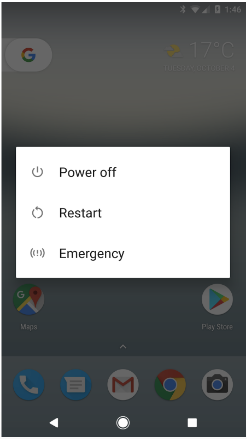All mobile devices sold in India from January 1st, 2017 must provide a panic button to meet Indian Department of Telecommunications (DoT) requirements. To address these regulatory requirements, Android includes a reference implementation of the Emergency Affordance feature to enable a panic button on Android devices.
This feature is enabled by default in Android 8.0 and higher releases, but must be patched into existing builds of earlier releases. Currently, this feature is exclusively targeted at devices sold in the Indian market but can be included on all devices sold throughout the world as the feature has no effect outside India.
Examples and source
The Emergency Affordance feature is implemented in the Android Open Source Project (AOSP) frameworks/base project. It is available in the main branch and is enabled by default in Android 8.0 and higher releases.
This feature is currently available in the following branches and commits. This information is provided to enable device manufacturers to easily patch the necessary changes into their existing builds. Device manufacturers wanting to implement the AOSP reference emergency affordance feature can cherry-pick the commits from the applicable branches into their own builds.
Table 1. Cherry-picks for AOSP reference emergency affordance feature
| Branch | Commits |
|---|---|
| main | e0c3c66
Added Emergency affordance feature 42a4338 Added translations for emergency action string 4df8d64 Fixed an issue where the emergency affordance would show on tablets |
| nougat-dev | e6680d9
Added Emergency affordance feature 95e1865 Added translations for emergency action string a70bb89 Fixed an issue where the emergency affordance would show on tablets |
| marshmallow-dev | cd22634
Added Emergency affordance feature 13f51c6 Added translations for emergency action string 6531666 Fixed an issue where the emergency affordance would show on tablets |
| lollipop-mr1-dev | 5fbc86b
Added Emergency affordance feature 1b60879 Added translations for emergency action string d74366f Fixed an issue where the emergency affordance would show on tablets |
Implementation
The Emergency Affordance feature makes no changes to the APIs exposed through the Android Software Development Kit (SDK). When enabled and activated, the feature provides two triggers that can initiate an emergency call to 112, which is the single emergency number to be used in India and mandated by the Indian DoT regulations.
An emergency call is initiated by either:
| Long pressing the EMERGENCY button on the lockscreen |
Tapping the Emergency option in the Global Action Menu |
|---|---|

|

|
This feature introduces the following internal components:
- EmergencyAffordanceManager
frameworks/base/core/java/com/android/internal/policy/EmergencyAffordanceManager.java
- EmergencyAffordanceService
frameworks/base/services/core/java/com/android/server/emergency/EmergencyAffordanceService.java
EmergencyAffordanceManager
The EmergencyAffordanceManager provides an internal API to use the Emergency Affordance feature. It provides methods for initiating the emergency call and querying at runtime if the feature should be enabled.
void performEmergencyCall(). Initiates an emergency call.boolean needsEmergencyAffordance(). Determines if the feature should be active.
The feature may be permanently disabled at build time by changing the
EmergencyAffordanceManager.ENABLED constant to false.
This will cause needsEmergencyAffordance() to always return false
and prevent the EmergencyAffordanceService from starting.
EmergencyAffordanceService
The EmergencyAffordanceService is a system service that monitors
the Mobile Country Code (MCC) of all the detected cellular networks and the MCC
of the installed SIM cards. If any of the installed SIM cards or detected
cellular networks have a MCC matching one of India's MCCs (404 or 405) then the
feature will be enabled. This means the feature can be enabled in India even if
no SIM card is present. It is assumed the mobile network will permit
registration for emergency calls even without a SIM card installed. The feature
will remain enabled until a non-India SIM is installed and none of the detected
networks have a matching MCC.
The following resources and settings affect the behavior of the Emergency Affordance feature. If the config type is:
- Resource, it is an internal resource defined in
frameworks/base/core/res/res/values/config.xml. - Setting, it is a setting stored in the systems settings provider.
Table 2. Settings affecting behavior of emergency affordance feature
| Config Type | Name | Description |
|---|---|---|
| Resource | config_emergency_call_number | The phone number that is automatically dialed when the emergency call is
initiated. Type: String Default: 112 |
| Resource | config_emergency_mcc_codes | An array of Integers listing the MCCs the feature should be active in. Type: Array of Integers Default: {404,405} |
| Setting | emergency_affordance_number | Global setting override with the number to call with the emergency
affordance. This will only have an effect on debuggable build images (ie. build
type is userdebug or eng). This is intended only for testing. Type: String Default: unset |
| Setting | force_emergency_affordance | Global setting, whether the emergency affordance should be shown regardless
of device state. This is intended only for testing. Type: Boolean (1 or 0) Default: unset --> 0 |
Enable emergency calls to 112
The emergency affordance feature connects the call using the emergency dialer so that the call can be connected when the lock screen is active. The emergency dialer connects calls only to the list of numbers provided by the Radio Interface Layer (RIL) through the system property:
ril.ecclistwhen no SIM is installed.ril.ecclistSimSlotNumberwhen a SIM is inserted andSimSlotNumberis the slot ID of the default subscriber.
Device manufacturers using the emergency affordance feature must ensure that devices in India always enable 112 as an emergency number in the RIL.
Validation
While testing on a debuggable build, the number that is called can be changed with the following command:
adb shell settings put global emergency_affordance_number NUMBER_TO_CALL
Although this setting can be set on a normal user build, it will be ignored. To actually connect the call the number must be in the list of emergency numbers provided by the RIL. This can be temporarily set using the following command executed from a root shell on a userdebug device:
setprop ril.ecclist "$(getprop ril.ecclist),NUMBER_TO_CALL"
The following command can also be used to force the Emergency Affordance feature to be enabled even in the absence of an Indian mobile network being detected or an Indian SIM card being inserted.
adb shell settings put global force_emergency_affordance 1
At a minimum, it is recommend to test the following cases:
- Once activated, long pressing the EMERGENCY button on the lockscreen (Figure 1) initiates a call to the specified emergency number.
- Once activated, the Emergency item on the Global Action Menu is present and tapping it initiates a call to the specified emergency number.
- The feature is not activated in the absence of a detected Indian Mobile Network with a non-India SIM card installed.
- The feature is activated on the device when an Indian SIM card is installed, regardless of the detected mobile networks.
- The feature is activated on the device in the presence of an Indian Mobile Network, regardless of the SIM cards installed.
If a device includes supports multiple SIM cards, testing should ensure that the SIM MCC detection works correctly in each SIM slot. The Emergency Affordance feature is not governed by Android compatibility, so there are no Compatibility Test Suite (CTS) tests for it.
Frequently Asked Questions
Q. The emergency number 112 has not been commissioned yet in India. Should it still be used?
112 is the number that will be used in India as the Public Safety Answering Point (PSAP) as defined by the Integrated Emergency Communications and Response Systems (IECRS). Until the PSAP is commissioned, all calls to 112 will be routed to the existing 100 emergency number (though this is the responsibility of the carrier, not Android).
Q. What about other triggers such as triple-pressing the power button?
Device manufacturers may choose to implement additional triggers. However, while the Indian DoT approves triple-tapping the hardware power button, this trigger is not supported in the AOSP reference implementation as some widely used applications (e.g. the Camera app) use power button gestures that include repeated tapping of the power button. Such applications might interfere with the emergency dialer or the user may accidentally trigger the panic button while trying to trigger actions in these applications.
